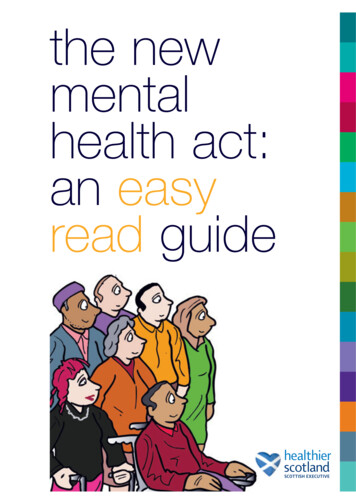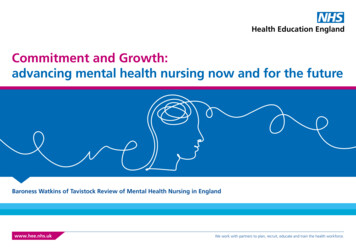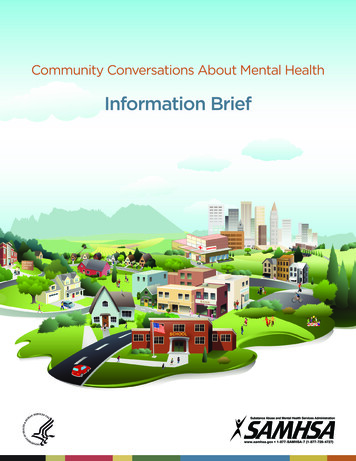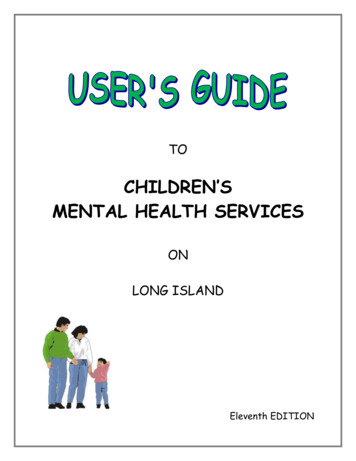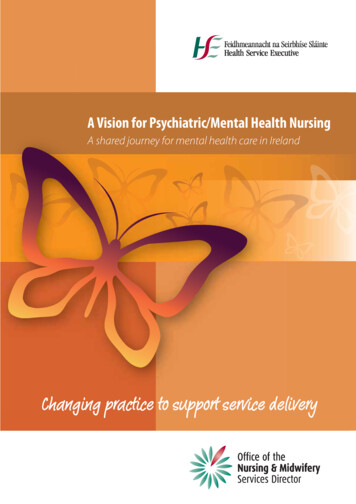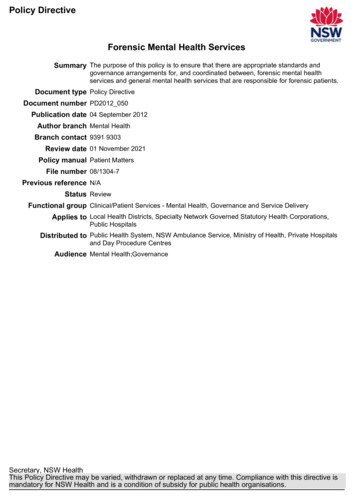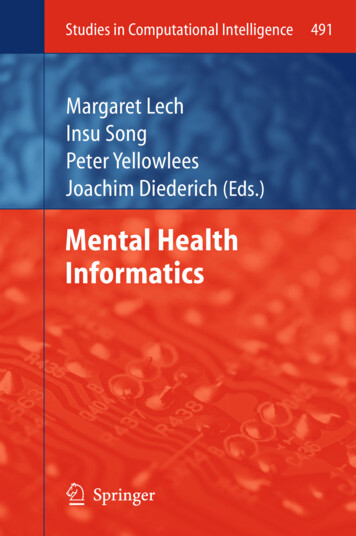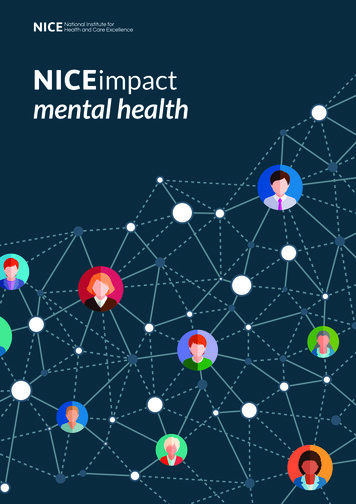
Transcription
mental health
NICEimpact mental healthOne in 4 adults experiences a mental healthcondition in any given year, and mental healthconditions are the largest single cause ofdisability in the UK. This report considers howNICE’s evidence-based guidance cancontribute to improvements in the care ofpeople with mental health conditions.This report highlights progress madeby the health and care system inimplementing NICE guidance. Werecognise that change can sometimesbe challenging and may requirepathway reconfiguration. It may alsorequire additional resources such astraining and new equipment.We work with partners including NHSEngland and Public Health Englandto support changes, and we also lookfor opportunities to make savingsby reducing ineffective practice. Wewill explore areas of unwarrantedvariation to understand the challengesof implementing the recommendationsdiscussed in this report.Common mental health disorders p4Over 1 million people received NICE-recommendedpsychological treatments for common mental health disordersin 2017/18. NICE is working with NHS England to assessdigitally-enabled therapies which offer the potential to expandservices further.Severe mental illness p8People with severe mental illness are at risk of dyingmuch earlier than other people. To help improve outcomes,NICE recommendations include early intervention for peoplewith a first episode of psychosis, offering comprehensivephysical health assessments and making psychologicaltherapies available.People’s experience of care p15Survey results suggest that more could be done toensure that people using specialist mental health servicesexperience good care as described by NICE.Spotlight on children andyoung people p18More children and young people are receiving specialist mentalhealthcare but there is unmet need. The NHS Long Term Planand a government green paper lay out plans to transformchildren and young people’s mental health provision.Commentary p20Paul Farmer, Chief Executive of Mind, reviewsrecent achievements and considers NICE’s role in improvingmental healthcare.2
NICEimpact mental healthWhy focus onmental health?NICE impact reports review how NICErecommendations for evidence-based andcost-effective care are being used in priorityareas of the health and care system, helping toimprove outcomes where this is needed most.331885guidelinesquality standardstechnology appraisalsImproving Access to PsychologicalTherapies assessment briefings3interventional procedureguidanceNICE provides evidence-based guidance and advice to helpimprove health and social care services. The uptake of NICEguidance is influenced by close relationships with partnerssuch as NHS England, NHS Improvement and Public HealthEngland (PHE).Since 2002 and the publication of NICE’s first clinicalguideline, on schizophrenia, we have produced an extensivesuite of guidance and quality standards to support theidentification and management of mental health conditions.Our guidance covers common and severe mental healthconditions in children, young people and adults.In 2015, the independent Mental Health Taskforce wasformed to create the Five Year Forward View for MentalHealth for the NHS in England. The NHS Long Term Planbuilds on this strategy and pledges to grow investment inmental health services faster than the overall NHS budget foreach of the next 5 years.NICE guidance is the foundation of many commitments inthese national strategies, including improvements in: access to psychological therapies, physical healthcare for people with severe mental illness,and people’s choice and control over their care.We routinely collect data which give us information aboutthe uptake of our guidance. To produce this report, we haveworked with national partners to select those data which tellus about how NICE guidance might be making a difference inthese priority areas of mental healthcare. They also highlightareas where there is still room for improvement.3
NICEimpact mental healthCommon mental healthdisorders in adultsCommon mental health disorders affect anestimated 1 in 6 adults at any one time. TheImproving Access to Psychological Therapies(IAPT) programme offers NICE-recommendedtreatments for these conditions.Common mental health disordersinclude depression and anxietydisorders such as generalised anxietydisorder, panic disorder, obsessivecompulsive disorder, body dysmorphicdisorder, post-traumatic stress disorderand social anxiety disorder.IAPT has made NICE-recommendedpsychological therapies for theseconditions more widely available butthere remains unmet need. NICE isworking with NHS England to identifyand assess digitally enabled therapieswhich offer the potential to expandservices further.NICE’s guideline on identification and pathways to carefor common mental health problems aims to improve howmental health conditions are identified and assessed.This is supported by a suite of guidance and quality standardson the recognition and management of depression andanxiety disorders.Estimates of the total prevalence of common mental healthdisorders vary, but data from the Quality and OutcomesFramework show that over 4.5 million adults had a diagnosisof depression in 2017/18. This is around 10% of all adultsregistered with a GP, up from around 6% in 2012/13, and thereis wide regional variation. The proportion of people with mentalhealth conditions is higher in areas with more deprivation;poverty can be a cause or consequence of mental ill health.The percentage of adults with a diagnosis of depression ranged from5% to 15% across England’s clinical commissioning groups in 2017/18Increasing access to evidence-based psychological therapiesfor people with common mental health conditions is a priorityin the Five Year Forward View for Mental Health and theNHS Long Term Plan. This section reviews how NICE iscontributing to that ambition.Psychological therapiesNICE recommends psychological therapies as part of astepped-care model for treating common mental healthdisorders. This means providing the least intrusive, mosteffective intervention first, and monitoring progressand outcomes to ensure the person moves to a higherstep if needed. NHS England’s IAPT programme deliverspsychological therapies in line with these recommendations.4
NICEimpact mental health2016/172012/132013/14The number of people who enteredtreatment after referral to IAPTservices, EnglandThe programme began in 2008 and NHS Digital has publishedannual data since 2012. The number of people receiving NICErecommended psychological therapies through the IAPTprogramme has more than doubled since then, from around435,000 in 2012/13 to over 1 million in 800,0001m2015201620172014The Five Year Forward View for Mental Health highlights that,at the time of publication in 2016, around 15% of people withanxiety and depression were being seen by IAPT services.NHS England plans to extend that to 25%, so that at least1.5 million adults each year will access NICE-recommendedcare by 2020/21. The NHS Long Term Plan commits to anadditional 380,000 adults being able to access IAPT servicesby 2023/24.IAPT for people with long term health conditions and medicallyunexplained symptomsNICE’s guideline on depression in adults with achronic physical health problem highlights thatdepression is approximately 2 to 3 times morecommon in people with a chronic physical healthproblem than in people who have good physical health.to offer IAPT services integrated with physicalhealthcare pathways.To help with implementation, an IAPT pathway forlong term physical health conditions and medicallyunexplained symptoms has been commissionedThe Five Year Forward View for Mental Healthby NICE on behalf of NHS England. This sets outrecommended that delivering psychologicalthe treatment pathway underpinning the accesstherapies to people with long term conditions should and waiting time standards. It references NICEbe prioritised in the expansion of IAPT.recommendations and provides evidence on whatworks, as well as local case studies of service-ledIn response, NHS England has introduced aexamples that describe how to make IAPT for longrequirement for all clinical commissioning groupsterm conditions a reality.5
NICEimpact mental healthDigitally enabled therapies50digital therapies presented toIAPT expert panel13digital therapies assessed aseligible for the programme5IAPT assessment briefingspublished3digital therapies recommended forevaluation in practiceThe Five Year Forward View for Mental Health: One YearOn highlights that digitally enabled therapies present anopportunity to broaden access to IAPT services and couldhelp deliver NHS England’s plans for IAPT expansion. NICEis working with NHS England to identify and assess digitallyenabled therapies which offer the potential to expandIAPT services.The new digitally enabled therapy assessment programmeaims to identify good quality, evidence-based digitally enabledpsychological therapies. The programme will use ongoingdata collection in IAPT services to assess whether patientoutcomes are at least as good as those achieved by NICErecommended, non-digital therapy. It will also determinewhether there are improvements in service efficiency bysaving therapist time.NICE is leading the first phase by selecting and assessingdigital therapies. Each digital therapy is assessed on itstherapeutic content, clinical evidence, expected resourceimpact and whether it meets NHS Digital’s digital standards.After reviewing the assessment evidence, NICE’s IAPT expertpanel decides whether the digital therapy is suitable for theevaluation in practice phase or not. They can also recommendthat it needs further development.Digital therapies which are recommended for the evaluationin practice phase will be assessed in selected IAPT servicesfor up to 2 years. The outcomes of this evaluation will helpservices choose high quality, evidence-based products whichare cost-effective and achieve good outcomes for those whowish to access therapy in this way.IAPT for people from black, Asian and otherminority ethnic groupsNICE’s quality standard on promoting health and preventingpremature mortality in black, Asian and other minorityethnic groups draws attention to areas of inequality, includingincreased health risks, poor access to and experience ofservices, and worse health outcomes. One area of inequalityhighlighted in the quality standard is mental healthcare.Historically, surveys have suggested that fewer people fromblack, Asian and other minority ethnic groups have accessed6
NICEimpact mental healthmental health treatment. In 2014, NHS Digital’s AdultPsychiatric Morbidity Survey found that 14% of people witha white British family background said they were receivingtreatment at the time of the interview, compared to only 7% ofpeople from minority ethnic groups.51%More recent data show that rates of IAPT treatmentcompletion and recovery vary by ethnicity. In 2017/18, around43% of all people referred to IAPT went on to completetreatment. However, for people from black, Asian or otherminority groups who were referred, only around 37%completed treatment and recovery rates were poorer.46%The Five Year Forward View for Mental Health emphasisedthe need to tackle inequalities. To help address this, since2017 NHS England’s Quality Premium has included a focuson improving mental health outcomes for people from black,Asian and other minority ethnic groups. This payment isintended to reward Clinical Commissioning Groups (CCGs) forimprovements in the quality of the services they commission.of all people moved to recoveryafter completing IAPT treatmentof people from a black, Asian orother minority ethnic groupmoved to recovery aftercompleting IAPT treatmentTo achieve this element of the payment, CCGs must showimprovement in the recovery rate of people accessing IAPTservices who are from a black, Asian or other minority ethnicgroup. Progress against this measure is now tracked in thequarterly Mental Health Five Year Forward View Dashboard.Improving access to mental healthcare for women ofsouth Asian family originTo help reduce mental healthcare inequalities,NICE’s quality standard on promoting health andpreventing mortality in black, Asian and otherminority ethnic groups states that people fromthese groups should be able to access mental healthservices in a variety of community-based settings.Birmingham and Solihull Mental Health NHSFoundation Trust identified that there were barriersto accessing mental healthcare for women of southAsian family origin. They adapted their IAPT serviceby developing a culturally sensitive treatment group,described in a NICE shared learning example.The group-based intervention, delivering care inline with NICE recommendations, is facilitated bypsychological wellbeing practitioners who speakHindi, Urdu, Punjabi or Bengali. Sessions are heldin community centres in order to reduce the stigmaand overcome reluctance to engage with mentalhealth services.Analysis of recent sessions showed a recovery rateof 54% for those who entered treatment with mildto moderate symptoms. A feedback exercise foundthat 95% of the women who took part in the groupsreported having a positive experience.7
NICEimpact mental healthSevere mental illnessPeople with severe and prolonged mentalillness are at risk of dying on average 15 to20 years earlier than other people. Goodphysical healthcare and access to evidencebased treatments are important to reducethis health inequality.People with severe mental illness havepsychological problems that mayseverely impact on their ability toengage in functional and occupationalactivities. Severe mental illnessesinclude schizophrenia, bipolar disorderand other psychoses.More people are starting treatmentearly for a first episode of psychosissince the introduction of a waiting timestandard based on NICE guidance.Monitoring of physical health isimproving but there is still more to do,and there appear to be opportunities toincrease the delivery of psychologicaltherapies as recommended by NICE.NICE’s guidance on the prevention and management ofpsychosis and schizophrenia aims to improve care throughearly recognition and treatment, and by focusing on longterm recovery. Our guidance on recognising, assessing andmanaging bipolar disorder aims to improve treatment andquality of life, and NICE guidance on depression covers thetreatment of people with complex and severe depression,which may include psychotic symptoms.Severe mental illness affects around 0.9% of the populationand numbers appear to be growing. Over 550,000 peopleregistered with a GP had a diagnosis of schizophrenia, bipolaraffective disorder or other psychoses in 2017/18, an increaseof over 50,000 since 2014/15. Recent analysis by PHEconfirms that severe mental illness is more prevalent in peopleliving in the most deprived areas.Over half a million people registered with a GP have beendiagnosed with a severe mental illnessTo improve outcomes for people with severe mental illness,the Five Year Forward View for Mental Health prioritiesinclude meeting physical health needs, increasing accessto psychological therapies and ensuring rapid access to aNICE-recommended care package for people with a firstepisode of psychosis. To deliver these priorities, the NHS LongTerm Plan sets out a commitment to introduce a new andintegrated community-based offer which will include accessto psychological therapies, improved physical healthcare,employment support, personalised and trauma-informedcare, medicines management and support for self-harm andcoexisting substance use.In this section, we review what we know about the uptake ofNICE recommendations underpinning many of these priorities.8
NICEimpact mental healthEarly intervention in psychosis servicesThe NICE quality standard on psychosis and schizophrenia,published in February 2015, states that adults with a firstepisode of psychosis should start treatment in earlyintervention in psychosis services within 2 weeks of referral.This is because the sooner people are able to access evidencebased treatments after the onset of psychosis, the better theoutcomes they achieve.Psychosis and schizophrenia aremental health conditions that affecthow a person thinks, feels andbehaves. The main symptoms arehallucinations such as hearing voicesor seeing things which are not reallythere, and delusions such as believingsomething is real or true when it is not.These are called psychotic symptoms.In 2014, NHS England established a programme to introduceevidence-based care pathways and waiting time standardsacross mental health. The care pathways are commissioned byNICE on behalf of NHS England, and each pathway referencesrelevant NICE recommendations and quality standards.For most people the symptoms startwhen they are young adults, but theycan happen at any age. The first time aperson has these symptoms is called afirst episode of psychosis.The early intervention in psychosis pathway, and accessand waiting time standard, was the first published in April2016 and reflects the NICE quality standard. The access andwaiting time standard requires that more than 50% of peopleexperiencing a first episode of psychosis are treated witha NICE-approved care package within 2 weeks of referral,increasing to 60% by 2020/21. Data from NHS England showthat, since the introduction of this standard, the percentage ofpeople starting treatment within 2 weeks as recommended byNICE has increased from around 65% to around 76%.The percentage of people whostarted treatment for earlyintervention in psychosis within2 weeks of referral, England10090Access and waiting timestandard arJune2017Since data collection started, there has been anMonth/Yearoverall increase in people reporting a return totheir previous level of mobility at 30 and 120days after admissionUser-dSeptDecMarJune2018SeptMobility data at 30 daysafter admission was notcollected in 2016.Dec9
NICEimpact mental healthThe second element of the access and waiting time standardis that all early intervention in psychosis services shouldbe delivering NICE-recommended care. Implementingthe Mental Health Forward View laid out a year-on-yeartrajectory to achieve this. In 2016/17, all services met thetrajectory by completing a baseline self-assessment againstNICE standards. To track progress and improvements indelivering NICE-recommended care, early intervention inpsychosis teams will continue to undertake an annual auditagainst NICE standards.The physical health of people with severemental illnessMany different factors may contributeto higher rates of physical illness inpeople with severe mental illness.Antipsychotic medication is linked tometabolic side effects including weightgain. Deprivation and lifestyle factorssuch as smoking, poor diet, substancemisuse and a lack of exercise may alsoplay a part.Many of these factors are linked to anincreased risk of cardiovascular disease(CVD), a general term for conditionsaffecting the heart or blood vessels.We looked at how NICE guidance isbeing used to identify and manageCVD risk, with a focus on people withsevere mental illness, in ourNICEimpact CVD prevention report.A recent PHE analysis of primary care records found thatpeople with severe mental illness have a higher prevalence ofobesity, asthma, diabetes, chronic obstructive pulmonarydisease (COPD), chronic heart disease, stroke and heart failurethan the general population.NICE’s guidance on bipolar disorder, psychosis and schizophreniarecommends that people with these conditions should havea comprehensive physical health check at least annually.In 2014, NHS England added an indicator in line with theserecommendations to the Commissioning for Quality andInnovation (CQUIN) scheme. To achieve this element of thepayment, providers must carry out health assessments anddeliver relevant treatments to people with psychoses.Data on the delivery of health checks and interventions arecollected by the National Clinical Audit of Psychosis and abespoke CQUIN audit carried out by the Royal College ofPsychiatrists. The CQUIN indicator identifies 5 cardiovasculardisease (CVD) risk factors which should be monitored:smoking status, BMI, blood glucose control, blood lipids andblood pressure. The audit reviewed the case notes of nearly8,000 adults living in the community with a diagnosis ofschizophrenia or schizo-affective disorder. In 2017, 42% hadmonitoring of all 5 factors, up from 34% in 2014.Monitoring of most of the individual risk factors has increased,although some remain less well monitored. The audit alsocollected data on whether interventions are delivered whenrisk factors are identified and found variation between ratesof different interventions. However, all intervention rates haveincreased substantially since 2013.10
Blood lipidsBlood pressureBMI/weight 52Smoking status586265895766Abnormal blood lipidsHigh blood pressure 25BMI over 25kg/m2 70Smoking59798629587852NICEimpact mental healthThe percentage of adults in the community with schizophrenia orschizo-affective disorder who received physical health monitoringand interventions, England and WalesBlood glucose control monitoredIntervention for abnormal blood glucose control57%20132017201759%Blood lipids monitored58%2013201757%2017Blood pressure monitored201362%201752%25%201766%BMI/weight monitored58%Intervention for BMI over 25kg/m²70%201352%2017201765%Smoking status monitored78%Intervention for smoking89%2013201786%2014CG178 psychosis andschizophrenia in adults UINgoal,improvingphysicalhealthcare in people with 34%2013severe mental illness, launched20172015AbnormalbloodQS80psychosisand lipidsschizophreniain adultspublished201329%2017High blood pressure201729%Intervention for high blood pressure2013201375%Intervention for abnormal blood lipids2013201334%201325%59%201379%2017The audit also looked at the case notes of around 650 peoplewith the same diagnoses receiving inpatient care. Monitoringrates were higher for this group. In 2017, 69% of people weremonitored for all 5 risk factors and intervention rates rangedfrom 61% for high blood pressure to 91% for smoking.75%Reducing premature mortalityby improving physicalhealthcare for people with severe mental illness remains anNHS England priority. Funding has been made available toensure that at least 60% of people who have severe mental52%illness receive NICE-recommended physical assessmentsand follow up from 2018/19 onwards. A new data collectionhas been established at clinical commissioning group level tomonitor delivery58% against this.BMI over 25kg/m270%2013201778%Smoking2013201759%79%11
NICEimpact mental healthSevere mental illness and substance misuseSubstance misuse refers to the use of legal or illicit drugs,including alcohol and medicines, in a way that causes mentalor physical damage. NICE’s guideline on the assessmentand management of coexisting severe mental illness andsubstance misuse highlights that approximately 40% of peoplewith psychosis misuse substances at some point in their life, atleast double the rate seen in the general population.Physical health monitoringBlood glucose controlBlood lipids58Blood pressure62BMI/weight 5265Smoking status89People with coexisting severe mental illness and substancemisuse have some of the worst health, wellbeing and socialoutcomes. NICE’s guideline on community health and socialadultsin thecommunitywithschizophreniaorcare Percentageservices for fectivewho received interventionsforand substancemisusedisordermakes recommendationson alesservices should address people’s wider health and social carePhysical health intervention 2013 2017needs, as well as other issues such as employment and housing.2013 201757595766Abnormal blood glucose control86The percentage of adults in thecommunitywithschizophreniaHarmful orhazardous useof alcoholor schizo-affective disorder whoreceived alcohol consumption andsubstance misuse monitoring andinterventions, England and WalesAlcohol consumption monitored201387%89%2017Intervention for substance misuse201389%201786%Blood pressure2013PswE72%201783%High blood pressure201462%2013National CQUIN goal, improving2017 healthcare in people with66%physicalsevere mental illness, launchedBMI/weight52%65%Smoking status201325%The National Clinical Audit of Psychosis reported on the58%proportion of2017people living in the communitywho receivedmonitoring foralcoholconsumption and substance misuse.BMIover 25kg/m2More people are70%alcohol2013now being asked about theirconsumption,2017and intervention rates have shownan78%encouraging increase since 2013.PsSmokingRates of monitoring and intervention were higher in people89%59%2013receiving inpatient care. In 2017, around 95% had their alcohol86%79%2017consumption and substance use monitored and over 90%received an intervention when relevant.20132017Abnormal blood glucose control2013Cd73%2013Substance misuse monitored201775Intervention for harmful or hazardous use of alcohol70%2017201334To helpidentify bloodsubstancemisuse, NICEthatAbnormallipids29 recommends52High bloodpressureshould25 routinely58healthcareprofessionalsask people withBMIover25kg/m27078known or suspected psychosis about their use of alcohol orSmoking5979 medicines, including illicit drugs.prescribedand non-prescribedLifestyle factors, including alcohol and drugs, are included inthe list of elements which should be monitored to meet therequirements of the national CQUIN indicator on improvingphysical healthcare in people with severe mental illness.34%12pW
NICEimpact mental healthThe Long Term Plan reiterates the need to integrate care forthose who are most vulnerable and receive care from severalorganisations. NHS England is developing a communityframework for mental health services to ensure people arereceiving consistent, timely access to evidence-based care inthe community, with improved care planning and coordination. They are also working closely with PHE to ensureadequate commissioning of substance misuse services by localauthority partners.Alcohol screening and interventions for hospital inpatientsPrompted by the CQUIN goal on improving thephysical health of people with severe mental illness,and with the aim of reducing alcohol-related harm inpeople with mental health conditions, South Londonand Maudsley NHS Foundation Trust has integratedNICE recommendations on alcohol screening andinterventions into trust policies. They described theirprocess in a NICE shared learning example.One of the actions taken by the trust was developinga course to give staff the knowledge and skills toconduct alcohol screening and deliver brief advice.It also ensured that staff know about, and can offerreferral to, specialist substance misuse services. Thetrust adapted the electronic patient record so thatprogress could be monitored, and improvements inboth screening and intervention rates were recorded.Psychological therapies for severemental illnessThe Five Year Forward View for Mental Health recommendedincreasing access to psychological therapies for people withpsychosis, bipolar disorder and personality disorder. NICErecommends 2 types of therapy for adults with psychosisor schizophrenia: cognitivebehavioural therapy for psychosis‘As a voice hearer and someone who experiences(CBTp) and family intervention.paranoia and “psychotic” experiences I have beenable to access psycho-social intervention talkingtherapy this summer after being in the mental healthsystem for 20 years. I have found it very, very usefulin terms of understanding how so much of whatI experience comes from extreme social anxietyand low self esteem’ Mind survey respondent ** From ‘We still need to talk: a report onaccess to talking therapies’,Mind / We Need to Talk CoalitionCBTp involves the person withpsychosis or schizophreniameeting a healthcare professionalon their own to talk about theirfeelings and thoughts, whichcan help them to find waysto cope with their symptoms.The National Clinical Auditof Psychosis found that, in 2017, just 26% of adults in thecommunity with a diagnosis of schizophrenia or schizo-affectivedisorder were offered CBTp. Of those, 52% took up the offer.13
NICEimpact mental healthFamily intervention aims to support families to work together.It can improve coping skills and relapse rates of adults withpsychosis and schizophrenia. The audit found that just 12% ofadults in the community who were in contact with their familywere offered family intervention, and 39% of those took the offerup. For nearly half the adults in contact with their family, therewas no record of family intervention being offered or considered.The questions in this audit have changed since 2013 so we donot know if there has been any improvement, and peoplereceiving care from early intervention in psychosis services arenot included in the audit sample. However, the data suggestthat NICE-recommended psychological therapies for peoplewith psychosis and schizophrenia are not widely delivered.Supporting people to find or stay in workThe Five Year Forward View for Mental Health describesemployment and health as a virtuous circle: suitable workcan be good for your health, and good health means you aremore likely to be employed. NICE quality standards state thatadults with bipolar disorder, psychosis or schizophrenia whowish to find or return to work should be offered supportedemployment programmes.However, the National Clinical Audit of Psychosis found thatonly 11% of people in the community with schizophreniaor schizo-affective disorder were employed, a student, orin unpaid work. The Care Quality Commission communitymental health survey found that less than a quarter of allpeople using specialist me
compulsive disorder, body dysmorphic disorder, post-traumatic stress disorder and social anxiety disorder. IAPT has made NICE-recommended psychological therapies for these conditions more widely available but there remains unmet need. NICE is working with NHS E


